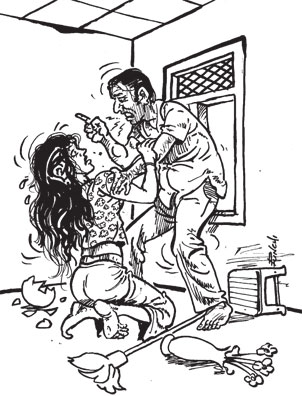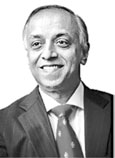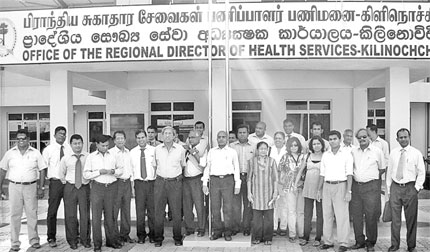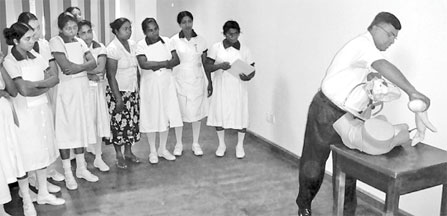
Domestic violence, a social and health problem
by Dheena Sadik
Domestic violence also known as family violence, battering and
spousal abuse is defined as inflicting physical injury by one family
member on another. However, this form of violence is not restricted to
physical harm alone and could indeed include harming the psychology of
the victim too.
 Dr. Kamanie Dassanayake, a doctor in psychology and natural medicine
said ''domestic violence is a pattern of physically, sexually and /or
emotionally abusive behaviour used by one individual to maintain power
over or control a partner in the context of an intimate or family
relationship. Abuse in relationships is very common and affects at least
one quarter of all relationships. Dr. Kamanie Dassanayake, a doctor in psychology and natural medicine
said ''domestic violence is a pattern of physically, sexually and /or
emotionally abusive behaviour used by one individual to maintain power
over or control a partner in the context of an intimate or family
relationship. Abuse in relationships is very common and affects at least
one quarter of all relationships.
If anyone feels they have a problem in controlling their anger and
tend to be abusive towards their partner or children, they should check
out the resources provided. As there is help available for them.
Otherwise, the damage they do for their loved ones cannot be
recovered in the long run.
Victims of domestic violence are often displaced from their home and
may have small children in need of services. Social workers, helpers or
law enforcement officials help victims to file police reports, receive
services, find work and locate to a safe place to stay. Anyone who helps
them assists victims with the day to day decisions to remain safe and
avoid future domestic violence.
"Sometimes in these cases, women have little or no self esteem. Most
came from poverty situations. Most women have children and always seem
unsure of their ability to support themselves and their children.
Alcohol reappears repeatedly. Aggression problems surface in both the
women and their children. Mostly, they seem lost and are searching for a
source of comfort and security. The environment they seek help should
give the woman and the child a sense of self worth, teaching them how to
beat the cycle of abuse."
When asked about domestic violence in Sri Lanka, Dr. Dassanayake
elaborated, "Domestic abuse in Sri Lanka is a large scale and complex
social and health problem. Sadly enough - the majority who are murdered
or crippled are not likely killed by a stranger during a holdup or
similar crime, but are killed by someone they know.
In one out of every six marriages the wife is physically abused.
Every fifteen seconds a woman is battered. Daily four women lose their
lives to their husbands or boyfriends."
According to Dr. Dassanayake, research on family abuse has
consistently found the phenomenon to be associated with low
socioeconomic status, social stress, social isolation and personality
problems or psychopathology.
Traditional theories on the causes of domestic abuse focuses on
factors such as social alienation, unemployment, substance abuse, past
child abuse, psychopathology and depression. It is important also to
examine this issue from medical and public health perspectives.
So now the obvious question arises why a woman would stay in an
abusive relationship. For many women, Dr. Dassanayake revealed that
there are no other sources of financial support or housing. The
responsibility of child care further complicates the problem. The most
serious reason for concern is the fear of retribution by the abuser.
Justice
"The criminal justice system needs to start a victim relocation
program for domestic abuse victims. This would ensure their safety and
allow them enough courage to leave a horrible situation. There are more
animal shelters in some countries than women shelters. Our nation
detests racism and protest animal cruelty. Why are women and children
still subjected to torture and violence in their own homes at the hands
of their husbands and fathers?"
Dr. Kamanie added, "In a politically correct world too many of us
still view women and children as inferior property. It is time to
declare war on domestic violence. It will always be a part of our
culture. The media portrays women as sex symbols and often with a very
noticeable lack of intelligence.
"Often doctors turn their backs on damage left as a result of abuse
because of fear of embarrassing their patients. Women are still not
considered equal and historically it was acceptable to beat your wife if
she was out of line. With today's broken marriages and extensive abuse
of alcohol and drugs, the matter will only get worse.
"If strong initiatives are not instilled now, there will be many
unnecessary deaths due to the rise in abuse."
The warning signs and symptoms for an individual to know it's time to
consult a professional psychologist are when the abuse is psychological
rather than physical.
Noticing and acknowledging the signs of an abusive relationship is
the first step. Or when someone you know have any warning signs and
description of abuse - Reach out.
Abuse
It can be domestic abuse, drug abuse, elder abuse. Warning signs of
suicide are not difficult to spot. It is helpful to encourage the person
to seek professional mental health help from a therapist.
"It is important as a community to stand up and voice our protest
against domestic violence. The victims have to stand up and speak out.
It will take millions of very loud voices to end the cycle of abuse.
Every woman gets married to live happily. Nobody deserves to be
surprised by pain and torture, be it physical or emotional.
Domestic violence should not happen to anyone ever. But it does and
the results may bring so much damage physically or psychologically.
There is help and the victims should always voice it and let know the
hurt. Maybe you have lived with abuse. Maybe it happened once. Maybe you
work or live next to someone who is being abused right now.
Whoever you are - your safety as well as the ones attached to you is
a priority.
No one deserves unhappiness from another human being."
Exercise reduces body fat while preserving muscle
Exercise and healthy eating reduce body fat and preserve muscle in
adults better than diet alone, according to a study funded and conducted
by National Institute of Diabetes and Digestive and Kidney Diseases
(NIDDK), part of the National Institutes of Health. The study was
recently published online in Obesity and will be in a future print
edition.
 NIDDK senior investigator Kevin Hall, analysed the individual effects
of daily strenuous exercise and a restricted diet by examining data from
11 participants from the reality television program "The Biggest Loser."
The program shows obese adults losing large amounts of weight over
several months. Participants were initially isolated on a ranch followed
by an extended period at home. NIDDK senior investigator Kevin Hall, analysed the individual effects
of daily strenuous exercise and a restricted diet by examining data from
11 participants from the reality television program "The Biggest Loser."
The program shows obese adults losing large amounts of weight over
several months. Participants were initially isolated on a ranch followed
by an extended period at home.
"By including the show's contestants as voluntary study participants,
this research took advantage of a cost-efficient opportunity to study a
small group of obese individuals already engaged in an intensive
lifestyle intervention," said Hall, who has no financial ties and no
other affiliation to the show.
Researchers measured body fat, total energy expenditure and resting
metabolic rate - the energy burned during inactivity - three times: at
the start of the program, at week 6, and at week 30, which was at least
17 weeks after participants returned home. Participation in the program
led to an average weight loss of 128 pounds, with about 82 percent of
that coming from body fat, and the rest from lean tissue like muscle.
Preserving lean tissue, even during rapid and substantial weight loss,
helps maintain strength and mobility and reduces risk of injury, among
other benefits.
Hall used a mathematical computer model of human metabolism -
currently intended for research conducted by scientists and health
professionals - to calculate the diet and exercise changes underlying
the observed body weight loss. Because the TV program was not designed
to directly address how the exercise and diet interventions each
contributed to the weight loss, the computer model simulated the results
of diet alone and exercise alone to estimate their relative
contributions.
At the competition's end, diet alone was calculated to be responsible
for more weight loss than exercise, with 65 percent of the weight loss
consisting of body fat and 35 percent consisting of lean mass like
muscle. In contrast, the model calculated that exercise alone resulted
in participants losing only fat, and no muscle. The simulation of
exercise alone also estimated a small increase in lean mass despite
overall weight loss.The simulations also suggest that the participants
could sustain their weight loss and avoid weight regain by adopting more
moderate lifestyle changes - like 20 minutes of daily vigorous exercise
and a 20 percent calorie restriction - than those demonstrated on the
television program.
More than two-thirds of U.S. adults age 20 and older are overweight
or obese, and more than one-third of adults are obese. Excess weight can
lead to type 2 diabetes, heart disease, high blood pressure, stroke, and
certain cancers.
"This study reinforces the need for a healthy diet and exercise in
our daily lives," said NIDDK Director Dr. Griffin P. Rodgers. "It also
illustrates how the science of metabolism and mathematical modelling can
be used to develop sound recommendations for sustainable weight loss -
an important tool in the treatment of obesity - based on an individual's
unique circumstances."
- MNT
SLCOG annual sessions in progress
|

Prof. Sir Sabaratnam Arulkumaran
|
The annual scientific sessions of the Sri Lanka Obstetricians and
Gynaecologists (SLCOG) which opened on October 19 at the BMICH will
continue till today with the participation of hundreds of Obstetricians
from Sri Lanka and many experts from overseas.
It will be followed by a Safe Motherhood program at Nuwara Eliya on
October 23 where a significant amount of deaths of pregnant women
continue to take place in the tea estates.
The SLCOG, a voluntary professional medical organisation with a
membership of over 300, works in 68 government specialist care hospitals
and private institutions and overseas. All Obstetricians in the country
are its members. There are more than 175 RCOG members, said a spokesman
for SLCOG.
The SLCOG was set up in 1953 with the objective of reducing maternal
deaths in the country.
Sri Lanka has achieved the lowest maternal death rate in the South
East Asian region and the SLCOG has played a major role in this effort.
 The spokesman said many international organisations such as FIGO,
World Health Organisation and United Nations have commented on these
achievements. The spokesman said many international organisations such as FIGO,
World Health Organisation and United Nations have commented on these
achievements.
However, our belief is, "No mother should die during a pregnancy from
a preventable cause" and we have been working tirelessly towards this
goal, he said.
Also, for every death, there are hundreds who have been saved from a
near death and many end up in life-long health problems and we have
planned to address this issue of "Severe Acute Maternal Morbidity" as a
priority during the next year.
"We have widened our goals to cover the whole lifecycle of a woman as
well as the pertinent issues in the males. This vision is clearly
documented in our Strategic Goals Document. To reach these nationally
important targets we are conducting many programs," he said.
Here are some of the most important activities:
SLCOG launched these programs in 2002 in the belief that to prevent
maternal mortality and morbidity, every health worker should know how to
attend to an obstetric emergency. We have developed a training program
(Emergency Obstetrics Care - EMOC) to train doctors, midwives and nurses
through various workshops islandwide. These training programs are
statutory as the government has recognised the need. The target is to
cover all health workers within several years and also to keep updating
the trained staff. The funding is from the contributions received by the
SLCOG from well-wishers and donors.
"We have prioritised the districts according to the regional MMR and
covered almost all provinces including the North and the East by
conducting these workshops and one workshop is held every month.
"SLCOG has sought assistance from the RCOG to upgrade the EMOC
program. During these workshops, in addition to the EMOC for health
workers we are conducting multiple Health education programs using the
team of SLCOG resource personnel for all strata of the society.
These include School teachers, Schoolchildren, Samurdhi Niyamaka /
Grama Niladhari / Gemi Diriya and other community leaders, Security
Forces, Pregnant mothers and their husbands and the public."
The tsunami took Sri Lanka unawares and over 30,000 people lost their
lives.
Hospitals were destroyed, pregnant mothers lost all their records and
access to antenatal care was affected as a result.
SLCOG set up a Task Force and sent teams equipped to provide total
maternity care, to all affected districts.
 Emergencies were attended to, records were prepared from scratch
including on the spot laboratory investigations and ultra sound scanning
and Ante natal care were restored. Emergencies were attended to, records were prepared from scratch
including on the spot laboratory investigations and ultra sound scanning
and Ante natal care were restored.
The exodus of 350,000 displaced persons was an enormous challenge to
the health system of the country.
"We estimated that there would be about 3,000 pregnant mothers among
these people.
SLCOG intervened promptly to defuse a crisis when these camps were
set-up to provide maternity care for those displaced.
The Health Ministry had already set-up a special unit to address
health-related issues in these displaced Sri Lankans but not especially
on this most crucial area," the spokesman said.
Following a request from the SLCOG, the Secretary of Health appointed
a Maternity Care Task Force with SLCOG members. Not a single death was
recorded during this period.
Here are some of the activities that were provided during this
period. These activities were sustained for more than six months till
the local health system could take over. All these services were
provided by our members on a voluntary basis free in addition to their
normal work in government hospitals.
. Registered all pregnant women (more than 3,000).
. Converting the small local hospital at Cheddikulum with no
facilities, to a specialised maternity hospital within two to three
weeks by providing a new operation theatre, maternity wards, labour
rooms and a blood bank.
. Mobilised our members and our post graduate trainees and provided a
24-hour specialist service to all the camps and the hospital.
. Antenatal clinics were conducted daily in all camps for IDPs (Six
zones)
. Strengthening the Vavuniya General hospital until the facilities in
the Cheddikulum Hospital was established.
. Three-hundred deliveries were managed by our members.
The SLCOG held discussions with the Defence Secretary Gotabaya
Rajapaksa to plan out a mechanism to improve the maternity services in
the North and the East in areas of resettlement. We reiterated that
quality maternity care in these areas is a must if people were to settle
with a reasonably content mindset.
As a mark of recognising our services the Federation of International
Gynaecology and Obstetrics (FIGO) and Royal College of Obstetricians and
Gynaecologists of UK (RCOG) have decided to give appreciation mementos
at the annual scientific sessions.
The Presidents of the two international organisations are
participating in the services. Prof. Sir Sabaratnam Arulkumaran the
current FIGO President is a Sri Lankan who studied at Mahajana
Vidyalaya, Telippalai, Jaffna and graduated from the Colombo Medical
school.
He was also a Past President of the RCOG and Knighted by Her Majesty,
the Queen of Great Britain, recently.
He now leads (FIGO) which is the mother organisation of all O G
associations in the world.
This is the highest position in our profession and Sri Lanka can be
justifiably be proud of this achievement.
In the past he has helped Sri Lankan post graduate doctors in many
ways specially by finding training positions in the United Kingdom.
A Memorandum of Understanding (MOU) will be signed today by RCOG
President Dr. Tony Falconer at the Waters Edge, Battaramulla.
The Sri Lanka College of Obstetricians and Gynaecologists scientific
annual sessions 2012 which opened on October 17 at the BMICH with the
participation of foreign and Sri Lankan doctors will continue till
October 23.
|


